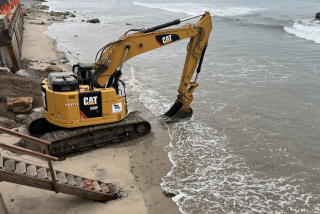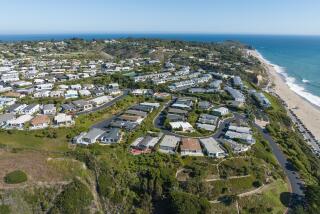Malibu Colony Rejects Public Beach Use
Residents of Malibu Colony, the oceanfront enclave that is home to scores of movie stars and show-business moguls, have rejected a proposal to open their beach to the public for so-called “passive uses,” such as sitting on the sand, sunbathing and taking a dip.
As a result, a dispute between the California Coastal Commission and 18 colony homeowners appears headed for a hearing in Los Angeles County Superior Court. The two sides had been trying for more than a year to negotiate an agreement on how much public access to allow in exchange for coastal permits to build protective seawalls.
The public now has the right only to walk along the beach, without stopping, below the mean high-tide line--essentially the area where the sand is wet.
The residents’ decision leaves commission Executive Director Peter Douglas “very disappointed.” Douglas said he was notified last week in a letter from Sherman Stacy, attorney for the 18 homeowners who want the seawall.
The argument dates back to the severe rains of 1982, which prompted the 18 to ask for permission to build a wood bulkhead to keep storm-driven waves from battering their million-dollar beach bungalows.
The commission granted the permit on the condition that residents dedicate for public use the beach area from the ocean to a point 10 feet south of the new bulkhead.
The 18 residents chose to sue--challenging the constitutionality of the coastal access requirement--rather than give up their privacy.
They later suggested allowing the public the right only to walk on the beach during the day. The colony would open a rusting chain-link fence that separates the private beach from state-owned Surfrider Beach and Malibu Lagoon State Park. But outsiders would not be able to stop and spend time on the sand. Residents also requested a 10-foot privacy buffer between their decks and the public-use part of the beach.
But coastal commissioners said those terms were unacceptable.
Then homeowners’ representatives--a group calling itself the Save Our Beach Committee--agreed with commission staff on a compromise: the public’s right to the beach for “passive use” from half an hour before sunrise to half an hour after sunset. The colony residents would get 20 feet of private sand between their homes and the public sector. And the colony would be responsible for maintaining the beach.
Coastal commissioners approved the compromise in a closed-door session early this year. At the time, there was hope that the colony beach would be open for the summer season.
Colony residents were not impressed with the suggested compromise.
“The majority of people” along the colony beachfront “were not involved in the bulkhead,” said Frank Davis, one of the litigants against the commission.
More to Read
Sign up for Essential California
The most important California stories and recommendations in your inbox every morning.
You may occasionally receive promotional content from the Los Angeles Times.










